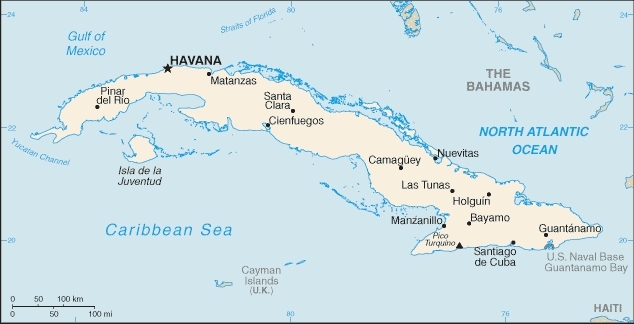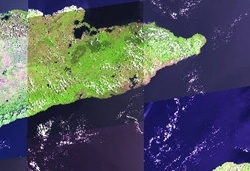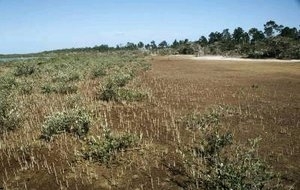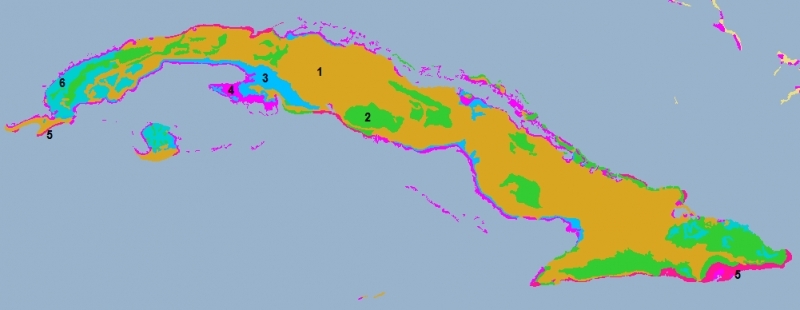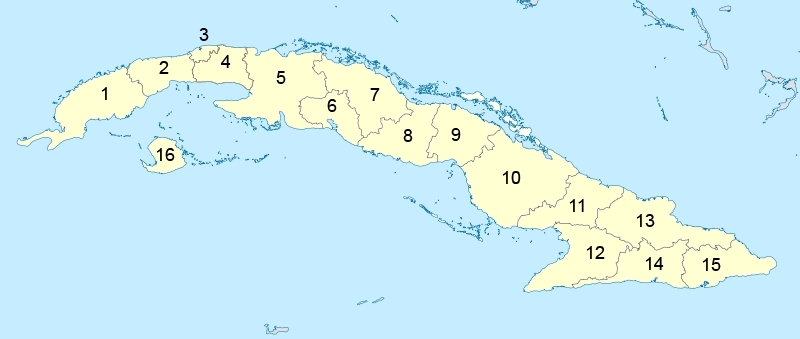Cuba
Countries and Regions of the World Collection 
Cuba is an island nation of eleven million people in the Caribbean Basin. It consists of the island of Cuba, the Isla de la Juventud, and several archipelagos. It is the most populous insular nation in the Caribbean.
Havana is the largest city in Cuba and the country's capital. Santiago de Cuba is the second largest city.
The human population of Cuba exceeds 11 million people,
Principal environmental issues include:
- air pollution and water pollution;
- coral reef damage from overfishing and sewage discharge;
- biodiversity loss; and,
- deforestation.
The native Amerindian population of Cuba began to decline after the European discovery of the island by Christopher Columbus in 1492 and following its development as a Spanish colony during the next several centuries. Large numbers of African slaves were imported to work the coffee and sugar plantations, and Havana became the launching point for the annual treasure fleets bound for Spain from Mexico and Peru.
Spanish rule eventually provoked an independence movement and occasional rebellions that were harshly suppressed. The United States intervention during the Spanish-American War in 1898 assisted the Cubans in overthrowing Spanish rule. The Treaty of Paris established Cuban independence from the US in 1902 after which the island experienced a string of governments, mostly dominated by the military and corrupt politicians.
Fidel Castro led a rebel army to victory in 1959; his iron rule held the subsequent regime together for nearly five decades. He stepped down as president in February 2008 in favor of his younger brother Raul Castro.
Cuba's Communist revolution, with Soviet support, was exported throughout Latin America and Africa during the 1960s, 1970s, and 1980s. The country faced a severe economic downturn in 1990 following the withdrawal of former Soviet subsidies worth $4 billion to $6 billion annually. Cuba at times portrays the US embargo, in place since 1961, as the source if its difficulties. Illicit migration to the US - using homemade rafts, alien smugglers, air flights, or via the southwest border - is a continuing problem. The US Coast Guard intercepted some 1,000 individuals attempting to cross the Straits of Florida in fiscal year 2011.
The United States has territorial control over 45 square miles of the island around Guantánamo Bay, which it gained to right to lease in perpetuity by treaty in 1903 (a provision now contested by the Cuban government) at which it maintains a naval base. Note that while Guantanamo Naval Base is leased by the US, it remains, officially at least, part of Cuba. The Guantanamo base is chiefly used for the detention of international terrorists, who have committed acts of crime or terror against the USA.
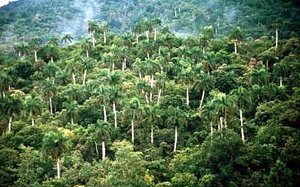 Cuban pine forest in the Sierra del Rosario Biosphere Reserve, Cuba. (Photograph by WWF-Canon/Michel Roggo)
Cuban pine forest in the Sierra del Rosario Biosphere Reserve, Cuba. (Photograph by WWF-Canon/Michel Roggo) Contents
Geography
Location: Caribbean, island between the Caribbean Sea and the North Atlantic Ocean, 150 kilometers south of Key West, Florida
Geographic Coordinates: 21 30 N, 80 00 W
Land use: arable land: 27.63%, permanent crops: 6.54%, other: 65.83% (2005)
Natural hazards: the east coast is subject to hurricanes from August to November (in general, the country averages about one hurricane every other year); droughts are common
Current environmental issues: Air pollution and water pollution; biodiversity loss; deforestation
Area: 110,860 sq km (all land)
arable land: 27.63%
permanent crops: 6.54%
other: 65.83% (2005)
Land Boundaries: 29 km bordering the US Naval Base at Guantanamo Bay note: Guantanamo Naval Base is leased by the USA.
Coastline: 3735 km
Maritime Claims: Territorial sea to 12 nautical miles; contiguous zone to 24 nautical miles; and, an exclusive economic zone to 200 nautical miles.
Natural Resources: Cobalt, nickel, iron ore, chromium, copper, salt, timber, silica, petroleum, arable land.
Terrain: Mostly flat to rolling plains, with rugged hills and mountains in the southeast. The highest point is (Pico Turquino) (2,005 meters).
Climate: Tropical; moderated by trade winds; dry season (November to April); rainy season (May to October).
Topography of Cuba. Source: Public Domain.
Ecology and biodiversity
The Caribbean Islands Biodiversity Hotspot consists mainly of three large groups of islands between North and South America: the Bahamas, the Lesser Antilles, and the Greater Antilles (Puerto Rico, Jamaica, Cuba, and Hispaniola, which includes the Dominican Republic and Haiti). While the hotspot spans more than four million square kilometers of ocean, it covers roughly 230,000 km2 of land area, with the four islands of Cuba, Hispaniola, Jamaica and Puerto Rico making up around 90 percent of land area.
|
Satellite view of the cactus scrub, southeast |
Cuban dry forest on Isla de la Juventud, Cuba. |
|
Cuban moist forest in the Sierra del Rosario Biosphere |
Greater Antilles mangroves on Isla de la Juventud, Cuba. |
Ecoregions of Cuba. Source: World Wildlife Fund.
- The dry forests of Cuba (orange) occupied most of the island’s plains and lowlands as well as some submontane zones along the coast or with specific edaphic characteristics (serpentinites, karstic limestone), representing more than 50% of the original natural vegetation. Currently, most of these forests have been replaced by anthropic vegetation or changed into savannas. There are multiple types of dry forest, some of them with a high level of endemism and distinctive species.
- The wet forests of Cuba (green) retain exceptionally distinctive insular flora and fauna, with many species, genera and families unique to its forests that have retained various relict taxons. The island’s long-standing isolation has made it possible for these relict taxons (Organism) to continue and many unique groups have also diversified. Many of the old lines that survive in these forests are extinct on the nearby continents. The rich flora and diverse fauna should be pointed out, particularly land snails. At present, these forests are seriously reduced. Expansion in the production of cacao, coffee and tobacco as well as mining and other human activities represent a serious threat in some areas.
- The wetlands of Cuba represent about four percent of the island's territory and include habitats with unique and ideal vegetation for numerous organisms such as manatis, crocodiles, fish, and turtles, many resident and particularly migrant birds and numerous endangered endemic species. The Zapata Swamp, the largest wetland in Cuba, is also the largest in the Caribbean, and the best preserved to date in the Antilles, although it is currently subject to numerous threats.
- Bahamoan-Antillean mangroves (pink) - Situated on large islands, the Greater Antillean mangroves have relatively high levels of endemic wildlife, including the Cuban crocodile Crocodylus rhombifer found on the Zapata peninsula of Cuba, and several birds. Some protected areas that are important centers of both floral and faunal endemism are the Desembarco del Granma National Park, also a World Heritage Site, where mangroves are part of an assemblage of habitats that include coral reefs and sea grass beds, that are all located within a system of marine terraces that create altitudinal and climatic diversity within a small area.
- Representing about three percent of Cuba’s original vegetation, the cactus scrublands of this Caribbean island (red) are a cactus rich plant formation of great national value due to the high degree of both plant and animal endemisms and as important centers of diversity for the island. They are located primarily on the southern coast of Oriente, as well as different patches on the west coast and to a lesser extent in the central part of the island, and are always associated with dry coastal climates. The conservation status is vulnerable, particularly due to threats such as overgrazing and habitat conversion (Habitat destruction).
- The [../151564/[Cuba]n pine forests] (blue) are located in bipolar form in the island's west and east. In the east they are abundant in the province of Pinar del Río surrounding the Sierra de los Organos particularly in the northern and southern plains and on the northern half of Isla de la Juventud. In the east, there are small patches around the Sierra del Cristal and Nipe-Sagua-Baracoa Mountains and in the Sierra Maestra. There is concern about the future of this ecoregion, as seventy percent of the original forest has been destroyed (Deforestation) and fires are a major threat to the remaining forest.
The Gulf of Mexico large marine ecosystem is characterised by its tropical climate. Cuban coral reef systems are threatened chiefly by sewage outfalls and by overfishing. (Jones et al, 2004) Coral reefs off Havana Bay have been damaged by water pollution delivered by the Almendares and Quibú rivers, and the underwater sewage outfall east of the Havana Bay entrance. The nutrient enrichment from this water pollution favours fleshy and filamentous algae on the reefs near Havana Bay, Río Quibú, Playa El Chivo and also near the entrance of Mariel Bay. The Gulf of Mexico is partially isolated from the Atlantic Ocean. Important hypotheses concerned with the growing impacts of water pollution, overexploitation, and environmental changes on sustained biomass yields of fisheries are under investigation for this Large Marine Ecosystem.
See also Biological diversity in the Caribbean Islands.
National Parks:
- Alejandro de Humboldt National Park (Parque Nacional Alejandro de Humboldt) - also a World Heritage Site
- Caguanes National Park (Parque Nacional Caguanes)
- Zapata Swamp (Ciénaga de Zapata)
- Desembarco del Granma National Park - also World Heritage Site
- Guanahacabibes National Park (Parque Nacional Guanahacabibes)
- Jardines de la Reina National Park (Parque Nacional Jardines de la Reina
- Sierra Cristal National Park (Parque Nacional Sierra Cristal)
- Turquino National Park (Parque Nacional Turquino)
- Viñales National Park (Parque Nacional Viñales)
Biosphere Reserves:
- Sierra del Rosario
- Cuchillas del Toa
- Península de Guanahacabibes
- Baconao
- Ciénaga de Zapata
- Buena Vista
People and Society
Population: 11,075,244 (July 2012 est.)
Cuba is a multiracial society with a population of mainly Spanish and African origins. Cuba was officially an atheist state from 1959 until a constitutional change in 1992 abolished atheism as the state creed and provided for the separation of church and state. At that time, the Communist Party also lifted its ban on members with religious beliefs. The largest organized religion is the Roman Catholic Church, but evangelical Protestant denominations continue to grow rapidly. Baptists, Methodists, Jehovah’s Witnesses, and Pentecostal churches are some of the largest Protestant denominations. Afro-Cuban religions, a blend of native African religions and Roman Catholicism, are widely practiced. There are also small groups of Jews and Muslims. See the Department's report on international religious freedom for further information regarding religion in Cuba.
Ethnic groups: white 65.1%, mulatto and mestizo 24.8%, black 10.1% (2002 census)
Age Structure:
0-14 years: 17.3% (male 984,607/female 931,167)
15-64 years: 71.1% (male 3,947,047/female 3,932,128)
65 years and over: 11.7% (male 583,757/female 708,624) (2011 est.)
Population Growth Rate: -0.115% (2012 est.)
Birthrate: 9.96 births/1,000 population (2012 est.)
Death Rate: 7.52 deaths/1,000 population (July 2012 est.)
Net Migration Rate: -3.59 migrant(s)/1,000 population (2012 est.)
Illicit emigration is a continuing problem; Cubans attempt to depart the island and enter the US using homemade rafts, smugglers, direct flights, or falsified visas. Also, Cubans use non-maritime routes to enter the US including direct flights to Miami and over-land via the southwest US border
Life Expectancy at Birth: 77.87 years
male: 75.61 years
female: 80.27 years (2012 est.)
Total Fertility Rate: 1.45 children born/woman (2012 est.)
Languages: Spanish
Literacy: 99.8%
Urbanization: 75% of total population (2010)
History
Spanish settlers established the raising of cattle, sugarcane, and tobacco as Cuba's primary economic pursuits. As the native Indian population died out, African slaves were imported to work the ranches and plantations. Slavery was abolished in 1886.
Cuba was the last major Spanish colony to gain independence, following a lengthy struggle begun in 1868. Jose Marti, Cuba's national hero, helped initiate the final push for independence in 1895. In 1898, the United States entered the conflict after the USS Maine sank in Havana Harbor on February 15 due to an explosion of undetermined origin. In December of that year, Spain relinquished control of Cuba to the United States with the Treaty of Paris. On May 20, 1902, the United States granted Cuba its independence but retained the right to intervene to preserve Cuban independence and stability in accordance with the Platt Amendment. In 1934, the Platt Amendment was repealed. The United States and Cuba concluded a Treaty of Relations in 1934 that, among other things, continued the 1903 agreements that leased the Guantanamo Bay naval base to the United States.
Independent Cuba was often ruled by authoritarian political and military figures who either obtained or remained in power by force. Fulgencio Batista, an army sergeant, organized a non-commissioned officer revolt in September 1933 and wielded significant power behind the scenes until he was elected president in 1940. Batista was voted out of office in 1944 and did not run in 1948. Both those elections were won by civilian political figures with the support of party organizations. Running for president again in 1952, Batista seized power in a bloodless coup 3 months before the election was to take place, suspended the balloting, and began ruling by decree. Many political figures and movements that wanted a return to the government according to the constitution of 1940 disputed Batista's undemocratic rule.
On July 26, 1953, Fidel Castro, who had been involved in increasingly violent political activity before Batista's coup, led a failed attack on the Moncada army barracks in Santiago de Cuba in which more than 100 died. After defending himself in a trial open to national and international media, he was convicted and jailed, and subsequently was freed in an act of clemency, before going into exile in Mexico. There, he organized the "26th of July Movement" with the goal of overthrowing Batista, and the group sailed to Cuba on board the yacht Granma, landing in the eastern part of the island in December 1956.
Batista's dictatorial rule fueled increasing popular discontent and the rise of many active urban and rural resistance groups, a fertile political environment for Castro's 26th of July Movement. Faced with a corrupt and ineffective military--itself dispirited by a U.S. Government embargo on weapons sales to Cuba--and public indignation and revulsion at his brutality toward opponents, Batista fled on January 1, 1959. Although he had promised a return to constitutional rule and democratic elections along with social reforms, Castro used his control of the military to consolidate his power by repressing all dissent from his decisions, marginalizing other resistance figures, and imprisoning or executing thousands of opponents. An estimated 3,200 people were executed by the Cuban Government between 1959 and 1962 alone. As the revolution became more radical, hundreds of thousands of Cubans fled the island.
Castro declared Cuba a socialist state on April 16, 1961. For the next 30 years, Castro pursued close relations with the Soviet Union and worked to advance the geopolitical goals of the Soviet Union, funding and fomenting violent subversive and insurrectional activities and participating in foreign interventions until the demise of the U.S.S.R. in 1991.
Relations between the United States and Cuba deteriorated rapidly as the Cuban Government expropriated U.S. properties and moved toward adoption of a one-party communist system. In response, the United States imposed an embargo on Cuba in October 1960, and, in response to Castro's provocations, broke diplomatic relations on January 3, 1961. Tensions between the two governments peaked during the October 1962 missile crisis.
Throughout the 1970s and 1980s, Cuba expanded its military presence abroad, spending millions of dollars in exporting revolutions; deployments reached 50,000 troops in Angola, 24,000 in Ethiopia, 1,500 in Nicaragua, and hundreds more elsewhere. In Angola, Cuban troops, supported logistically by the U.S.S.R., backed the Popular Movement for the Liberation of Angola (MPLA) in its effort to take power after Portugal granted Angola its independence. Cuban forces played a key role in Ethiopia's war against Somalia and remained there in substantial numbers as a garrison force for a decade. Cubans served in a non-combat advisory role in Mozambique and the Congo. Also, Cuba used the Congo as a logistical support center for Cuba's Angola mission. In the late 1980s, Cuba began to pull back militarily. Cuba removed its forces unilaterally from Ethiopia, met the timetable of the 1988 Angola-Namibia accords by completing the withdrawal of its forces from Angola before July 1991, and ended military assistance to Nicaragua following the Sandinistas' 1990 electoral defeat.
As a result of the 2003 crackdown on dissidents, the EU adopted a Common Position on Cuba to leverage cooperation to demand greater respect for human rights and encourage government reforms. The EU remains divided on the Common Position, with many members pushing to replace it with a bilateral agreement that includes human rights provisions, a shift that the Cuban Government has lobbied for.
Canada maintains a robust trade and investment relationship with Cuba, with a large presence by the Canadian mining firm Sherritt Corp. Also, Canada is the largest source of foreign tourists who visit Cuba each year, reaching nearly one million visitors in 2010, representing 37% of total visitors.
Spain is among the most important foreign investors in Cuba. Spanish economic involvement with Cuba is primarily centered on joint venture enterprises in tourism. Spain and Canada alternate as Cuba’s third- and fourth-largest trade partners behind Venezuela and China.
Cuba's bilateral relationship with Venezuela has helped, in part, to keep the Cuban economy afloat. The "Integral Cooperation Accord" signed by Fidel Castro and Venezuelan President Hugo Chavez in 2000 laid the groundwork for a quasi-barter exchange of Venezuelan oil for Cuban goods and services that has since become important for Cuba.
Government
Cuba is a communist state headed previously the dictator General Raul Castro and a cadre of party loyalists. Castro replaced his brother Fidel Castro as chief of state, president of Cuba, and commander-in-chief of the armed forces on February 24, 2008. The first Communist Party Congress (CPC) since 1997 was held in April 2011, where Raul Castro was officially named first secretary of the Communist Party. He announced that 80-year-old Jose Ramon Machado Ventura would remain second-in-charge and Vice President Ramiro Valdes would remain as number three. The CPC also marked Fidel Castro’s formal resignation from official responsibilities within the party, although he will likely remain an important symbolic figure. Also proposed at the congress were two 5-year term limits for top party and government positions, but the party will not take up the issues of succession and its role in government again until January 2012, when it will hold a smaller party conference. The Cuban Government seeks to control most aspects of Cuban life through the Communist Party and its affiliated mass organizations, the government bureaucracy, and the state security apparatus. The Ministry of Interior is the principal organ of state security and control.
According to the Soviet-inspired Cuban constitution of 1976, the National Assembly and its Council of State have supreme authority. Since the National Assembly meets only twice a year for a few days each time, the 31-member Council of State wields power. A Council of Ministers, through its nine-member executive committee, handles the administration of the economy, which is state-controlled except for a small private market sector. Raul Castro is President of the Council of State and Council of Ministers, and Jose Ramon Machado Ventura serves as First Vice President of both bodies. In total, there are five Vice Presidents in the Council of State and seven in the Council of Ministers.
Although the constitution theoretically provides for independent courts, it explicitly subordinates them to the National Assembly and to the Council of State. The Supreme Court is the highest judicial body. Due process is routinely denied to Cuban citizens, particularly in cases involving political offenses. The constitution states that all legally recognized civil liberties can be denied to anyone who opposes the "decision of the Cuban people to build socialism."
The Communist Party is constitutionally recognized as Cuba's only legal political party. The party monopolizes all government positions, including the Council of State and judicial offices. Though not a formal requirement, party membership is a de facto prerequisite for high-level official positions and professional advancement in most areas. A small number of non-party members have been permitted by the controlling Communist authorities to serve in the National Assembly. The Communist Party through its front organizations approves candidates for all elected offices. Citizens do not have the right to change the government.
Government Type: Communist state
Capital: Havana - 2.14 million (2009)
Administrative divisions: 15 provinces (provincias, singular - provincia) and 1 special municipality* (municipio especial):
1. Pinar del Rio; 2. Artemisa; 3. La Habana; 4. Mayabeque; 5. Matanzas; 6.Cienfuegos; 7. Villa Clara; 8. Sancti Spiritus; 9. Ciego de Avila; 10. Camaguey; 11. Las Tunas; 12. Granma; 13. Holguin; 14. Santiago de Cuba; 15. Guantanamo, 16. Isla de la Juventud*,
Independence Date: 20 May 1902 (from Spain 10 December 1898; administered by the US from 1898 to 1902); not acknowledged by the Cuban Government as a day of independence.
Legal System: civil law system based on Spanish civil code. Cuba has not submitted an International Court of Justice (ICJ) jurisdiction declaration. It is a non-party state to the International criminal court (ICCt).
International Environmental Agreements
Cuba is party to international agreements on: Antarctic Treaty, Biodiversity, Climate Change (United Nations Framework Convention on Climate Change (full text)), Climate Change-Kyoto Protocol, Desertification, Endangered Species, Environmental Modification, Hazardous Wastes, Law of the Sea, Marine Dumping, Ozone Layer Protection, Ship Pollution, Wetlands. Cuba has signed but not ratified an international treaty on Marine Life Conservation.
Economy
The government continues to balance the need for economic loosening against a desire for firm political control.
GDP Growth
Real gross domestic product (GDP) grew by 2.1% in 2010, according to official statistics. However, Cuba uses a unique “social” method for calculating GDP which makes its figures impossible to compare with any other country in the world. The reported growth reflected a slight improvement on the 1.4% growth in 2009 and 1.9% growth the Cuban Government had forecast for 2010.
Economic Structure
The Cuban Government continues to adhere to socialist principles in organizing its state-controlled economy. Most of the means of production are owned and run by the government and, according to Cuban Government statistics, about 83% of the labor force is employed by the state. An additional 5% of the labor force is employed by cooperatives closely connected with the state. Only 12% of the labor force works in the private sector, including private farmers, artists, and 142,000 self-employed ("cuentapropistas"), representing less than 3% of the entire workforce. More than 60% of the workforce is employed in non-productive sectors.
Challenges
The Cuban economy suffers first and foremost from a lack of productivity and an overdependence on the external sector. Cuba suffered a significant decline in gross domestic product of at least 35% between 1989 and 1993 as the loss of Soviet subsidies laid bare the economy's fundamental weaknesses. To alleviate the economic crisis, in 1993 and 1994 the government introduced a few market-oriented reforms, including opening to tourism, allowing some foreign investment, legalizing the dollar, and authorizing self-employment for some 150 occupations. These measures resulted in modest economic growth, although the official statistics are deficient and provide an incomplete measure of Cuba's real economic situation. From 2000 to 2009, Cuba experienced a series of severe economic disruptions, including lower sugar and nickel prices, increases in petroleum costs, devastating hurricanes in 2001, 2004, and 2008, a major drought in the eastern half of the island, increasing external debt, liquidity issues, and stagnant or decreasing agricultural and industrial productivity. Significant economic assistance from Venezuela, and to a lesser degree China, has helped keep the Cuban economy afloat.
Living conditions in 2010 remained below 1989 levels. Moreover, the gap in the standard of living is widening between those with access to convertible pesos and those without. Jobs that can earn salaries in convertible pesos or tips from foreign businesses and tourists have become highly desirable. Over $1 billion in yearly remittances exacerbates the gap.
Prolonged austerity and the state-controlled economy's inefficiency in providing adequate goods and services have created conditions for a flourishing informal economy in Cuba. As the variety and amount of goods available in state-run peso stores has declined and prices at convertible peso stores remain unaffordable to most of the population, Cubans have turned increasingly to the black market to obtain needed food, clothing, and household items. Pilferage of items from the work place to sell on the black market or illegally offering services on the sidelines of official employment is common. A report by an independent economist and opposition leader speculates that more than 40% of the Cuban economy operates in the informal sector. In the last few years, the government has carried out an anti-corruption campaign, including the creation of a Comptroller General’s Office, repeated street-level crackdowns, and ongoing ideological appeals. So far, these measures have yielded limited if any results.
Venezuela
Fifteen years after the demise of the Soviet Union the Cuban Government found in Hugo Chavez’s Venezuela a new benefactor. The politically motivated preferential relationships with this country have replaced tourism as the main engine of growth for the Cuban economy since the second half of 2004. Its main component has been the exchange of medical services for oil at indexed prices and with long-term financing of up to 50% at subsidized interest rates. The transfer of financial resources from Venezuela to Cuba has also materialized in credits for projects at concessionary interest rates, the creation of joint ventures and a large number of cooperation projects.
As a whole, the preferential economic relationship with Venezuela has allowed the Cuban Government to more than double its import capacity, which had historically been closely related to GDP growth, and to carry out multibillion dollar investments both in infrastructure and productive sectors. This factor, together with almost tripled nickel prices in the world market between 2004 and 2008, explains the high growth rates registered in this period, but also allowed (now former) President Fidel Castro to start reversing some of the liberalizing and decentralizing reforms introduced in the 1993-2003 period.
Economic Reforms
In his 2008 inaugural address, Raul Castro said the Cuban Government would "advance in an articulate, sound and well-thought out manner" a series of measures that would raise the Cuban standard of living and tie individual prosperity to individual initiative and work performance. Castro also referred to excess "prohibitions and regulations," the simplest of which the Cuban Government would start removing "in the next few weeks." Ever since, at every opportunity, Castro has emphasized the need, even urgency, of enacting economic reforms. Since 2008, the government has authorized private farmers to work small plots of fallow public land; eliminated some subsidies, including food rations and subsidized lunches in workplace cafeterias; allowed a limited number of traders to operate privately; allowed used cars to be sold; and expanded access to certain previously restricted consumer goods (like cell phones, computers, and home appliances), among other things.
In April 2010, President Castro announced that there were more than 1 million “excess” workers in Cuba. In September 2010, the Cuban Government announced that more than 500,000 state workers, 10% of the workforce, would be laid off by the first quarter of 2011. To absorb these workers, the government said it would reduce regulations on private sector employment and expand the cooperative sector. In October 2010, the Cuban Government published new rules regulating the self-employment sector, including new activities (increasing the number of activities authorized to 178), opening the door for self-employed workers to hire labor, and introducing a new tax scheme to include taxes on sales, profit, payroll, and social security. By the end of 2010, the Cuban Government announced it had granted 75,000 new licenses for self-employment activities, which represented more than a 50% increase from the number authorized in 2009.
In April 2011, the Communist Party held a party congress for the first time in 14 years, and endorsed reforms previously introduced by President Raul Castro. Most notably, these reforms included allowing the purchase/sale of private property and possible credit mechanisms for small businesses and cooperatives. In late 2011, the Cuban Government announced that it would allow the donation, sale, and purchase of homes for the first time since the early days of the revolution.
The reality of economic reforms to date has not matched the government's urgent language, and the government has so far unveiled limited measures that have fallen short of true market liberalization. The government continues to hamper private sector growth with tight restrictions on the supply of goods and labor, high taxation that discourages hiring and profits, a ban on professional entrepreneurs, limited access to transportation and credit, a monopoly on importation, legal uncertainty and lack of transparency, and a host of other disincentives and restrictions. The reforms introduced so far, at a very slow pace, have been insufficient to reverse the deep systemic crisis first brought to light with the departure of Soviet economic support and exacerbated by a liquidity crisis that peaked in 2008-2009.
Key Sectors
Exports of professional services, mainly doctors and nurses to Venezuela, has been the main source of hard currency revenues for the Cuban economy since 2005.
Sugar, which was the mainstay of the island's economy for most of its history, has fallen upon troubled times. In 1989, production was more than 8 million tons, but by 2009, it had fallen to barely one million tons. Inefficient planting and cultivation methods, poor management, shortages of spare parts, and poor transportation infrastructure combined to deter the recovery of the sector. In June 2002, the government announced its intention to implement a "comprehensive transformation" of this declining sector. Almost half the existing sugar mills were closed, and more than 100,000 workers were laid off. The government promised that these workers would be "retrained" in other fields, though it was unlikely they would find new jobs in Cuba's stagnant economy. The sugar sector has continued to decline since the restructuring, with output registering a downward trend and averaging just 1.6 million tons during 2003-2009.
Tourism figures prominently in the Cuban Government's plans for development, and a top official casts it as at the "heart of the economy." Havana devotes significant resources to building new tourist facilities and renovating historic structures for use in the tourism sector. Roughly 1.7 million tourists visited Cuba in 2001, generating about $1.85 billion in gross revenues; by 2010 that number was 2.53 million, and had generated $2.4 billion.
According to the Cuban Ministry of the Basic Industry (MINBAS), nickel became the leading export and the top foreign exchange earner in 2007. In 2009, world nickel prices generated $870 million.
Cuba's pharmaceutical and biotechnology industry is another emerging sector, ranking third in foreign sales behind nickel and oil products, and ahead of traditional products such as tobacco, rum, and sugar. Exports of pharmaceutical and biotech products were between $300 and $350 million in 2007-2008 and jumped to $520 million in 2009.
Remittances also play a large role in Cuba's economy. Cuba does not publish accurate economic statistics, but academic sources estimate that remittances total from $800 million to $1.5 billion per year, with most coming from families in the United States. U.S. regulatory changes in 2009 and 2010 allow unlimited remittances to family members and religious organizations. The total amount of family remittances that an authorized traveler may carry to Cuba is now $3,000. In January 2011, the United States announced further changes that permit anyone under U.S. jurisdiction to send up to $500 per quarter to someone in Cuba. The changes also authorize unlimited remittances to religious organizations in Cuba.
In 2004, the government mandated that U.S. dollars be exchanged for "convertible pesos" or CUCs--a local currency that can be used only in Cuba and has no value internationally. The Cuban Government levies a 10% penalty on U.S. dollar exchanges that disproportionately affect Cubans who receive remittances from relatives in the United States. However, Western Union announced in December 2010 that it received permission from the U.S. and Cuban governments to remit payments in Cuban convertible pesos, thus avoiding the 10% surcharge. The Cuban Government captures these dollar remittances by allowing Cuban citizens to shop in state-run "dollar stores," which sell food, household, and clothing items at a high mark-up averaging over 240% of face value.
Foreign Investment and Debt
To help keep the economy afloat, Cuba has actively courted foreign investment in targeted sectors. Although majority foreign ownership has been permitted since 1995, it has seldom been allowed. Foreign investment often takes the form of joint ventures with the Cuban Government holding half of the equity, management contracts for tourism facilities, or financing for agricultural crops. The number of joint ventures has steadily declined since 2002 to 218 in 2009. Moreover, a hostile investment climate, characterized by inefficient and overpriced labor, dense regulations, and an impenetrable bureaucracy, continue to deter foreign investment.
In 2010, the government published a new law that extended the leases foreign investors could sign from 50 years to 99 years, exclusively for tourist properties, and said that it was in talks with international firms to build up to 16 new golf courses in 2011. None had moved forward by the close of 2011.
Cuba's precarious economic position is complicated by the high price it must pay for foreign financing. The Cuban Government defaulted on most of its international debt in 1986 and does not have access to credit from international financial institutions like the World Bank. Therefore, Havana must rely heavily on short-term loans to finance imports, chiefly food and fuel, and structured financial instruments tied to more stable revenue sources (e.g., nickel, tourism, and remittances). Because of its poor credit rating, an $18 billion hard currency debt, and the risks associated with Cuban investment, interest rates have reportedly been as high as 22%.
Gross Domestic Product (GDP) (Purchasing Power Parity): $114.1 billion (2010 est.)
GDP: (Official Exchange Rate): $57.49 billion (2010 est.)
GDP- per capita (PPP): $9,900 (2010 est.)
GDP- composition by sector:
agriculture: 4%
industry: 20.8%
services: 75.2% (2011 est.)
Industries: sugar, petroleum, tobacco, construction, nickel, steel, cement, agricultural machinery, pharmaceuticals
Natural Resources: cobalt, nickel, iron ore, chromium, copper, salt, timber, silica, petroleum, arable land
Currency: Cuba has two currencies in circulation: the Cuban peso (CUP) and the Convertible Peso (CUC)
Energy
Cuba produced 76,000 bbl/d of oil during the first half of 2006, while the country consumed 209,000 bbl/d.
Cuba's oil production has increased significantly in the past two decades, with the country only producing 16,000 bbl/d in 1984.
Most of Cuba's oil production occurs in the northern Matanzas province, resulting in a heavy, sour crude that requires special processing at the country's refineries.
See Energy profile of Caribbean
References
- Mayra Gómez. 2003. Human rights in Cuba, El Salvador, and Nicaragua: a sociological perspective. Psychology Press
- Human Rights Watch. 1992. Human Rights Watch World Report. 928 pages.
- Jones, L., G. Warner, D. Linton, P. Alcolado, R. Claro-Madruga, W. Clerveaux, R. Estrada, T. Fisher, K. Lockhart, M. Pardee, J. Pitt, C. Schelten and R. Wild , 2004 , Status Of Coral Reefs In The Northern Caribbean And Western Atlantic Node Of The GCRMN. . p: 451-470. in C. Wilkinson (ed.). Status of coral reefs of the world: 2004. Volume 2. Australian Institute of Marine Science, Townsville, Queensland, Australia.
- The Washington Post. 1991. UN names rights observer for Cuba. It rejects him.
- Website of the Government of the Republic of Cuba


